|
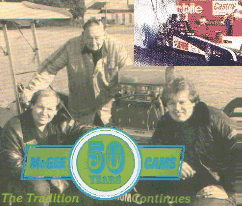
The Tradition Continues... A Brief History
In 1946, a young engineer named Hedley McGee founded McGee Cams in Sydney, Australia.
In addition to being the first successful designer and manufacturer of performance camshafts in Australia, Hedley was a pioneer in fuel injection.
His sons, Phil and Chris, eagerly joined their dad in the business as soon as they could,
helping their family and customer's cars dominate racing in Australia for decades (particularly midgets).
Both Phil and Chris became national championship-winning crew chiefs very early in their careers;
Chris bringing home the honors first as crew chief to Australian National Midget Champion George Tatnell in 1973.
For his contibution to Australian speedway racing, Hedley McGee was inducted into the Australian Speedway Hall of Fame in 2007.
Click here to learn more about Hedley's remarkable career.
The McGee Cams facility in Sydney's Kings Cross became a home away from home to most of the USAC drivers who toured Australia each summer.
Many of the McGee's US racing friends, including 1969 USAC Midget Champion Bob Tattersall,
were impressed with the McGee's camshafts and fuel injection systems and brought them back to the United States.
McGee Cams also developed camshafts for the Westlake speedway motorcycle engines and won a World Championship with Peter Collins in 1976.
This was the beginning of McGee Cams' success at the highest levels of international motor sports.
In 1973, Phil and Chris were invited to bring an Australian racing tour to the United States.
That trip really opened their eyes to the wealth of opportunities available in the States,
and they began to make plans to establish a McGee Cams & Injection facility in Southern California.
A few years earlier the McGee's had become enthralled with what they considered to be the most awesome performance racecars in the world:
Top Fuel Dragsters.
At the time, drag racing engines were all based on Detroit passenger car engine designs.
The McGee's oval track heritage convinced them a thoroughbred drag racing engine would have a real performance advantage in the nitro classes.
In 1974, Phil and Chris met with race officials in both Australia and the US and received a commitment, shook hands,
and began constructing the first generation of the McGee Quad Cam engine.
It was a 511 cubic inch, all aluminum V8 with four valves per cylinder operated by four overhead camshafts.
The engine produced more horsepower and provided greater reliability than any other engine at that time.
After competing with it in several races in Australia, the McGee family brought the engine to the 1975 NHRA Finals, at Ontario, California
where it earned Best Engineered honors.
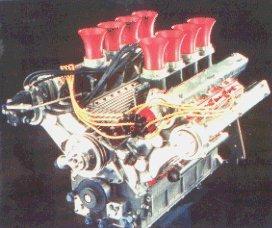
The first generation McGee Quad Cam Engine
|
During this time, there were many other projects coming out of the McGee facilities both in Australia and the United States.
The new McGee fuel injection system, developed for small block Chevy's, was enjoying considerable success in sprint car racing on the CRA and USAC circuits.
One of the top sprint car builders, who also owned Indy cars, approached the McGee's about designing a fuel system for the Indy 500,
where stock-block based engines were going to be allowed in 1979.
Chris accepted the challenge and at the first race tuned the car to the 8th fastest over all and a respectable finish, especially for an older car.
Many other companies had tried to do what Chris had done; however the McGee-tuned car was much faster and had better fuel economy.
The following weekend saw the team finish 4th at Milwaukee.
A month later they were leading the Pocono 500 when a crash took out the car with only two laps remaining.
Chris and his team were excited and pleased with such great success in their first year against much better-funded factory teams.
Unfortunately, the next year CART and USAC separated and the subsequent rule changes put an end to the project.
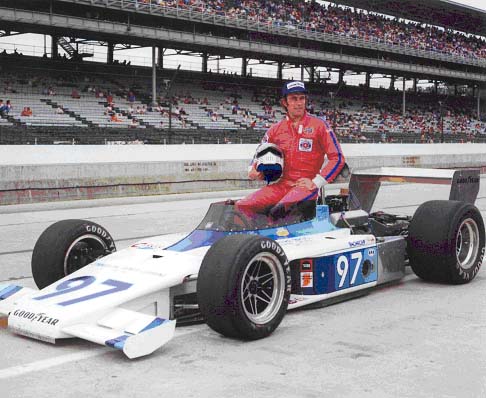
Phil Threshie (pictured) and Grant King Racing teammate, Gary Bettenhausen, competed at the Indianapolis, Milwaukee and Pocono Indy Car events in 1979.
|
To keep things running smoothly on both continents, Phil and Chris took turns running the shop here, which was located in Burbank.
A small apartment was just off the shop, which was convenient, since they were putting in long hours almost every day.
The winter of 1977 was a particularly wet one, and the apartment roof leaked. In disgust one day, Phil found a real apartment in Glendale.
A big plus for the Glendale apartment for Chris was the girl next door, Karen, who became his wife. After that Chris spent most of his time here.
After their father passed away in 1984, Phil and Chris continued to build on the success that their father had enjoyed for so many years.
The first generation McGee Quad Cams Engine had a crankcase with a four-cylinder block on each bank.
The blocks and heads were all one piece, which was very strong but very difficult to service between rounds.
In 1986, Phil and Chris made new moulds and the engine configuration was changed to a one-piece block with sleeves.
It was still quite strong because it did not have a cam tunnel or lifter bores to weaken it. The heads were billet, and the cam housings were magnesium.
Everything went together on dowels with o-ring seals. The only gaskets in the engine were the head gaskets and the pan gasket.
The engine was designed to accept all the popular racing hardware and shared the same bolt patterns to make installation easy.
The power that the McGee Quad Cam engine developed forced many of the manufacturers to redesign and develop stronger products.
Chris and Phil identified many of weaknesses in the available internal engine components,
and working together with other innovators in the industry, developed many components to make racing safer.

Although the original McGee Quad Cam Engine was very powerful, McGee Cams designed a new, easier to work on version of the engine in 1987.
|
By 1987 the McGee dragster, driven by Gary Beck, began to qualify at national events.
The team ascended through the Top Fuel field to became the leading part-time team on the circuit.
Many competitors and rival engine builders tried to have the McGee engine outlawed,
but the NHRA ruled that the engine could stay because its overhead cam design eliminated the major cause of catastrophic valve train failures
that were occurring in the other engines at the time.
The McGee house car continued to compete and was quite successful in the late 80's and early 90's.
Graeme Cowin won the Victorian Top Fuel Championship in 1984 with the McGee Quad Cam dragster.
Gary Beck won the Governor's Cup in Sacramento in 1989 with the McGee dragster. The track records still stand today.
In 1989 the McGee Cams dragster set track records at Famoso Raceway and LACR.
A McGee engine set the European Top Fuel speed record in 1991.
The McGee team was one of the favored teams involved in the quest for the first 300 MPH run.
On off-weekends Chris was also the crew chief for "Flash" Gordon Mineo's Nitro Funny Car,
which was runner up at the 1992 Houston Supernationals, and the low qualifier at Sonoma in 1992 and 1993 (setting a new track record).
Fellow Aussie David Grubnic joined the McGee Cams team, and took home the Top Speed of the Year award with an old Top Fuel car at El Mirage in 1993.
The team had planned to set records at Bonneville as well, but the event was rained out two years in a row.
Following that, to fulfill a promise made to Dave when he joined the team, the McGee's licensed David in the Top Fuel car in late 1994 at LACR.
David ran the 1995 Winternationals,
and the team traveled back East to compete on the IHRA Circuit, where the team climbed as high as #2 in points before returning home to California.
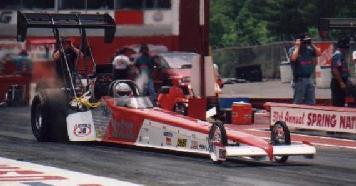
In 1995 "Aussie" Dave Grubnic climbed as high as #2 in the IHRA Top Fuel points race behind the wheel of the McGee Quad Cam Dragster.
|
The McGee's applied their 4-valve engine expertise to set several world records with a blown fuel motorcycle in England.
The motorcycle ran very fast and their unique pent-roof combustion chamber developed massive horsepower
even with a lower percentage of nitro methane than the cars ran at the time.
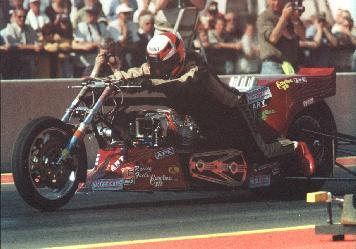
Brian Johnson's awesome Top Fuel Motorcycle set the world ET record several times during the 90's.
Brian, of England, and good friend, the late Elmer Trett, waged a Trans-Atlantic assault on both the world speed and ET barriers
with performance approaching the 5-second zone at close to 240 MPH.
|
The McGee's became one of the most written about teams in drag racing.
It was a very compelling story, because their budget was a fraction of what was available to the teams they raced against.
With a design ahead of it's time and a dream the McGee's continued to surprise even their critics.
Unfortunately the long hours and innovative engineering they contributed to the sport of drag racing were wiped out by the stroke of a pen
when NHRA mandated that all top-fuel teams race with one engine configuration,
and be limited to 2 valves per cylinder and also introduced lower nitro percentages, similar to what the motorcycle had used so successfully.
Phil and Chris began looking at other types of racing to invest in.
For several years, McGee Cams had been manufacturing cams for the sport of junior drag racing,
and so it seemed natural to begin building junior dragster engines and parts.
In 1998, Phil and his family moved to El Dorado Springs, MO, and set up a facility to build an impressive line of junior dragster products,
including the PM-1 Block.
Since getting involved with Junior Dragsters, Chris McGee's motors have won fifteen national championships/conference finals.
In addition, his engines have won countless divisional and track championships.
The horsepower per cubic inch they have attained has well surpassed projections and led the industry.
Chris's daughter, Kaitlyn, won the NHRA 50th Anniversary Championship event at San Diego in her rookie season.
She also has multiple wins at Pomona Raceway (half of those contested in 2002), won the 2003 Del Cox Classic,
and is the only two-time winner of the Toys for Kids event at LACR (2001, 2004).
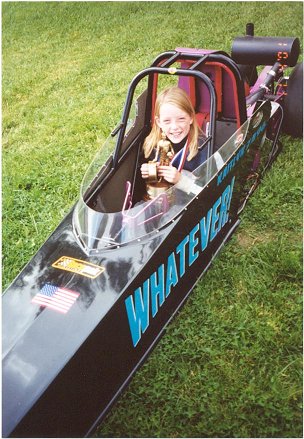
Kaitlyn McGee joined our sport in May '01 and had a rookie season to remember.
Her breakthrough race was a runner-up at Pomona, which earned her a spot in the Matco Shootout.
She also won several round wins in Denver and took home an NHRA 50th Anniversary" Wally" for her big win in San Diego.
|
And so the company that Hedley McGee founded almost sixty years ago continues to produce innovative, race-winning products.
If you want to be a part of the McGee story in the 21st century,
give Chris a call and join the racers who have discovered McGee championship-winning performance.
He intends to keep rewriting the record books and continue the race-winning traditions of his father for many years to come.
More pictures from the early days in Australia and the United States
|
| |
 |
|
| Dale Armstrong |
|
|
|
|
| |
 |
|
| Gary Beck |
|
|
|
|
| |
 |
|
| First drag car |
|
|
|
|
| |
 |
|
| Lenny Brock |
|
|
|
|
| |
 |
|
| Ray Oram |
|
|
|
|
| |
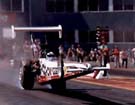 |
|
| Bob Reehl |
|
|
|
|


